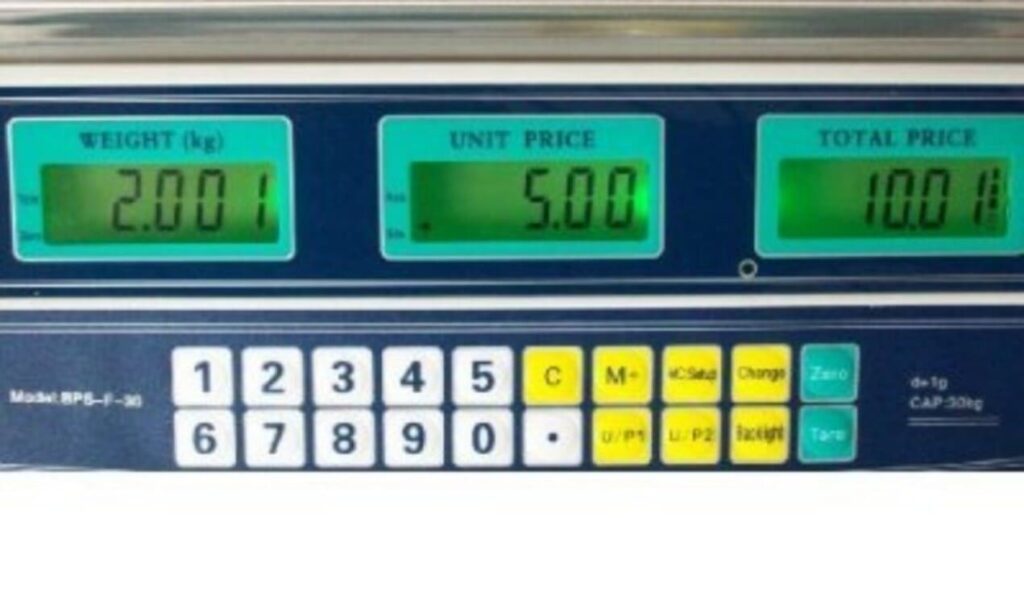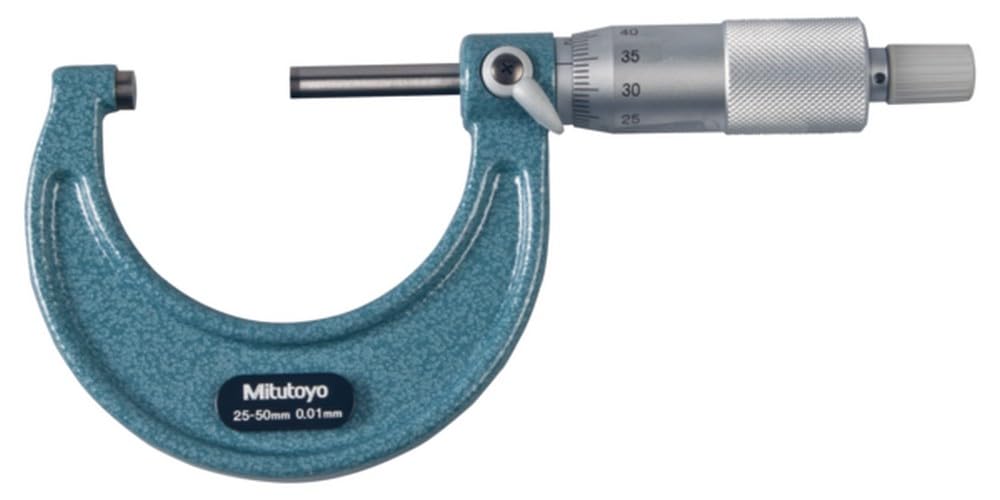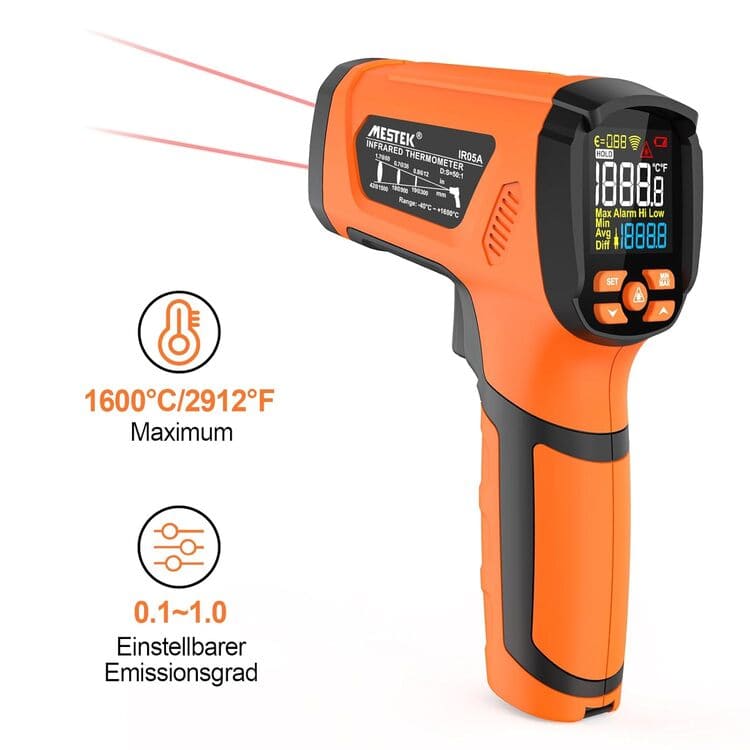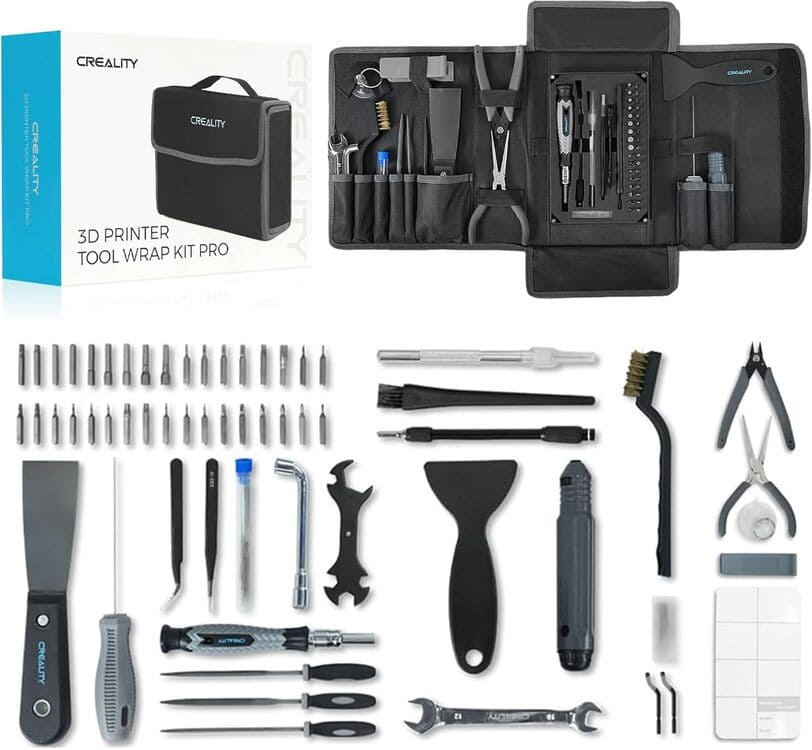G&G BPS F30/1 Market Scale 30 kg -1 g
Testergebnis
Nachfolgender Produkttest nach dem PM-Verfahren beginnt mit der Zusammenfassung der Testnoten sowie dem Test-Fazit. In nachfolgenden Kapiteln finden Sie umfassende Informationen unserer verbraucherorientierten Nutzungsanalyse, aufgeteilt in drei Bewertungsbereichen.
Ergebnis der Bewertungsbereiche & Gesamtnote
Produktspezifische Eigenschaften
Nutzung und Sicherheit
Meinung und Service
Gesamtnote
Test-Fazit
A functional evaluation examined the G&G BPS F30/1 digital price computing scale regarding material behavior, operational characteristics, and practical suitability. The stainless steel weighing platform demonstrates adequate mechanical resistance to abrasion while enabling straightforward hygiene maintenance through its removable configuration. The dual-sided LCD arrangement with six separate display fields provides simultaneous visibility of weight, unit price, and total price for both operator and customer—a configuration typically reserved for higher price segments. Measurement precision of 1 g across the 30 kg capacity range proves consistent, with instantaneous response to load changes eliminating delays during rapid transaction sequences. The protective housing exhibits no sharp edges, while rubber feet establish stable positioning even on moderately uneven work surfaces. However, the surface coating demonstrates limited moisture tolerance, deteriorating upon repeated water contact—a constraint for environments requiring frequent wet cleaning protocols.
The dual power architecture combining mains operation with integrated rechargeable battery delivers operational autonomy extending to multiple weeks under typical usage patterns, substantially exceeding specifications common in comparable equipment. At 3.7 kg total mass, the device maintains portability for mobile retail applications while remaining perceptible during extended carrying periods. The 21.5 × 28.5 cm platform accommodates a broad range of object dimensions, from small produce items to larger containers. Price memory capacity of approximately 50 PLUs with 2 direct-access buttons enables rapid recall of frequently transacted items, though menu navigation for remaining codes incrementally increases processing time relative to systems offering expanded direct-selection interfaces.
The absence of NTEP or legal-for-trade certification constitutes the primary functional limitation, categorically prohibiting deployment in regulated commercial transactions where weight determines pricing. This restriction fundamentally narrows the applicable use spectrum to non-commercial environments despite the device’s price calculation capabilities. No connectivity infrastructure exists—RS-232, USB, or Ethernet interfaces are absent—eliminating data logging, inventory system integration, or peripheral device connection. The lack of printer compatibility prevents label generation for pre-packaging workflows. Operating temperature constraints of 10-30°C restrict outdoor deployment in temperature-extreme climates, while the absence of IP-rating certification leaves water and dust ingress protection unquantified.
User feedback patterns (average 4.3 stars across 255 evaluations) reveal satisfaction with initial measurement accuracy, interface simplicity, and battery endurance during early ownership phases. The price positioning at 70 EUR delivers dual backlit displays and stainless steel construction at a cost point where single-display plastic alternatives dominate. Critical dissatisfaction emerges regarding battery system longevity: repeated reports document rechargeable cell failure after 1-2 years, with devices becoming inoperable despite mains connection—suggesting charging circuit defects rather than simple cell depletion. The instruction manual’s limitation to English and Chinese text excludes German language support, creating comprehension barriers in the primary European market. Surface coating degradation and isolated shipping damage to display assemblies indicate quality control variances in production or packaging engineering.
The device addresses price-sensitive purchasers prioritizing measurement accuracy and display functionality over regulatory compliance, system connectivity, or extended service life guarantees. It delivers competitive baseline performance for personal weighing applications, farmer’s market stalls operating under informal arrangements, or non-commercial institutional use where legal-for-trade certification holds no relevance. The configuration proves unsuitable for regulated retail environments, professional food service operations requiring health department compliance, or growing businesses anticipating integration with digital inventory management systems.
Ergebnisse der Bewertungsbereiche
1 | Produktspezifische Eigenschaften
Prüfparameter: Qualität & Verarbeitung
Prüfparameter: Größe & Gewicht
Prüfparameter: Design
Ergebnis: Produktspezifische Eigenschaften
The quality and workmanship of the G&G BPS scale demonstrates solid construction within its budget segment positioning. The stainless steel weighing platform provides adequate mechanical stability and facilitates hygienic maintenance through its removable design, though the two-handed removal process proves less convenient than single-handed alternatives. The housing exhibits no sharp edges or burrs that could pose handling risks, while rubber feet on the underside ensure stable placement even on slightly uneven work surfaces. CE certification confirms compliance with European safety standards. However, the surface coating shows limited resistance to moisture exposure, with the protective layer deteriorating upon repeated water contact—a notable limitation for applications requiring frequent cleaning. The absence of adjustable leveling feet restricts optimal calibration on irregular surfaces, while the overall material selection reflects cost-conscious engineering rather than premium-grade componentry.
The design prioritizes functional clarity over aesthetic sophistication. The dual-display configuration—with front and rear LCD screens—enables simultaneous viewing by operator and customer, a feature typically found in mid-range segments rather than budget products at this price point. Six separate display fields structure weight, unit price, and total price information logically, reducing cognitive load during transaction processing. The compact dimensions of 33 × 16 × 39 cm integrate efficiently into standard retail counter environments without excessive footprint demands. The silver housing maintains visual neutrality across diverse workplace settings. Critical weaknesses emerge in sunlight conditions: display contrast diminishes significantly under direct solar exposure, limiting outdoor or window-adjacent placement. The single color variant offers no customization options, while the absence of design elements for rapid visual component identification (such as color-coded sections) complicates intuitive operation in low-light conditions.
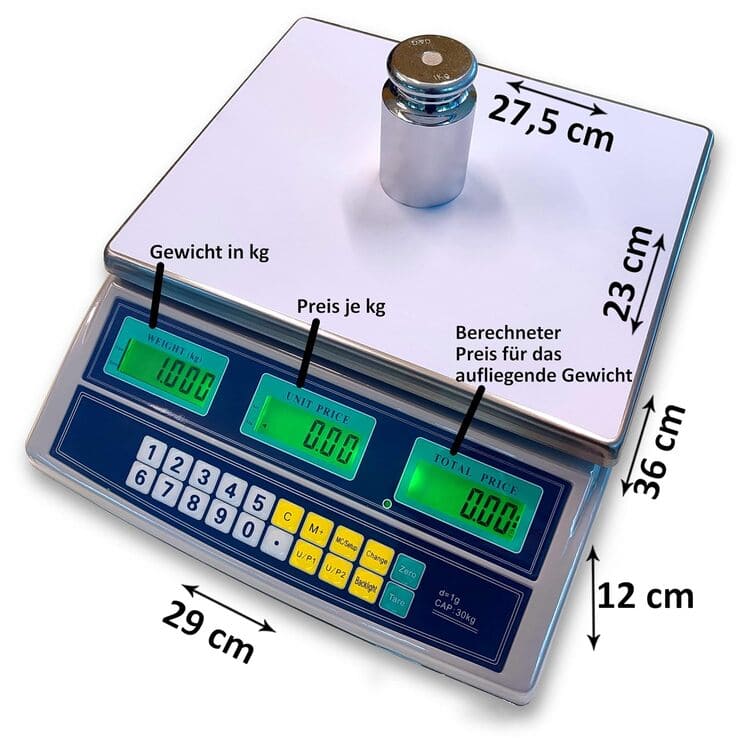
Einzelbewertung der Prüfparameter
Qualität & Verarbeitung
Design
Größe & Gewicht
Gesamt:
Produktspezifische Eigenschaftent
2 | Nutzung und Sicherheit
Prüfparameter: Funktionalität
Prüfparameter: Handhabung & Eignung
Prüfparameter: Sicherheit
Ergebnis: Nutzung und Sicherheit
The functionality delivers core weighing performance aligned with budget-segment expectations while exhibiting notable feature gaps relative to commercial-grade equipment. The 30 kg maximum capacity with 1 g resolution meets standard accuracy requirements for retail weighing tasks, responding instantaneously to load changes without perceptible measurement lag. The integrated price calculation function automates unit-price-to-total-price conversion, eliminating manual arithmetic errors during sales transactions. Price memory accommodates approximately 50 product codes (PLUs), with 2 direct-access buttons enabling rapid recall of frequently sold items—the remaining 20 PLUs require menu navigation. The tare function reliably subtracts container weight across the full measurement range. Overload protection activates at capacity exceedance, displaying an „8888“ error code rather than attempting measurement beyond specification limits. Critical limitations constrain commercial deployment: the absence of NTEP or legal-for-trade certification prohibits use in regulated sale-by-weight transactions, fundamentally restricting the device to non-commercial applications. No connectivity infrastructure (RS-232, USB, Ethernet) exists for data logging, inventory management system integration, or peripheral device connection—a significant disadvantage compared to mid-range competitors offering serial communication as standard. The lack of printer compatibility eliminates label generation capability, while the absence of unit switching (kg/lb/oz) restricts international usability.
Regarding usability and handling, the device demonstrates straightforward operation suitable for users without technical training. The dual power architecture—combining mains operation with integrated rechargeable battery—provides operational flexibility across fixed and mobile deployment scenarios. Battery endurance extends to multiple weeks under typical usage patterns, substantially exceeding the 36-hour specifications common in comparable products and eliminating frequent recharging interruptions. The charging cable employs a standard IEC C7 „figure-8“ connector, ensuring replacement availability without proprietary component dependencies. Operational stability persists on moderately uneven surfaces thanks to the rubber foot design, though the absence of height-adjustable feet prevents precision leveling on severely irregular countertops. Interface responsiveness proves adequate, with weight readings stabilizing within one second of load application. The two-handed requirement for weighing plate removal complicates rapid cleaning procedures compared to single-handed quick-release mechanisms found in premium alternatives. The limitation to 2 direct-access price buttons (versus the full 50 PLU capacity) necessitates menu navigation for less frequently sold items, incrementally increasing transaction time. Documentation availability presents challenges: the included manual provides English and Chinese text without German language support, potentially impeding comprehension for non-English-speaking operators in European markets (see Packaging & Labeling).
From a safety perspective, the scale incorporates fundamental protective features without advanced safeguards. CE marking confirms conformance to European Low Voltage and EMC Directives, establishing baseline electrical and electromagnetic compatibility. The housing construction eliminates sharp edges or protruding components that could cause laceration injuries during handling or cleaning. Rubber feet provide anti-slip anchoring on smooth work surfaces, reducing displacement risk during loading operations. Measurement stability under vibration conditions—such as adjacent equipment operation or minor table impacts—prevents erroneous readings that could compromise transaction accuracy. The overload protection mechanism prevents sensor damage from excessive load application by refusing measurement beyond rated capacity. However, the absence of IP-rating certification leaves water and dust ingress protection unquantified—a concern given the reported surface coating degradation upon moisture exposure. The restricted operating temperature range of 10-30°C prohibits outdoor use in cold climates or unheated storage facilities, while high-temperature environments (industrial kitchens, direct sunlight exposure) may exceed upper operational limits. No documentation addresses chemical resistance specifications, leaving compatibility with common cleaning agents uncertain. The lack of automatic shut-off timer conserves battery life but introduces no secondary safety benefit such as preventing prolonged overheating in continuous-operation scenarios.

Einzelbewertung der Prüfparameter
Funktionalität
Handhabung & Eignung
Sicherheit
Gesamt:
Nutzung & Sicherheit
3 | Meinung und Service
Die Kategorie Meinung und Service beschäftigt sich mit der Bewertung der Eigenschaften und Leistungen eines Produkts aus der Sicht der Nutzer sowie der Analyse des Services rund um das Produkt. Dabei werden verschiedene Prüfkriterien herangezogen, um ein umfassendes Bild zu erhalten.
Prüfparameter: Werbeversprechen
Prüfparameter: Verpackung & Kennzeichnung
Prüfparameter: Sicherheit
Prüfparameter: Preis-Leistung
Ergebnis: Meinung und Service
The evaluation of advertising claims reveals partial fulfillment of manufacturer assertions. The marketed „30 kg capacity with 1 g accuracy“ specification aligns precisely with measured technical performance, delivering the promised measurement range and resolution. The advertised dual power capability—combining mains adapter and rechargeable battery operation—functions as described, with both power modes operating without performance degradation. CE certification claims withstand verification through visible product marking. User feedback corroborates the „very accurate“ positioning, with measurement precision meeting expectations across the operational range. However, the „very high quality“ assertion requires qualification: while core weighing mechanics perform reliably, peripheral elements such as the moisture-sensitive surface coating demonstrate quality limitations inconsistent with premium-grade equipment. The claim of „extremely precise“ operation cannot be substantiated without calibration laboratory verification and long-term drift analysis—typical consumer-grade devices exhibit greater measurement variance than industrial reference standards. No claims regarding legal-for-trade certification appear in marketing materials, appropriately reflecting the device’s non-calibrated status, though this fundamental limitation receives insufficient prominence in product descriptions given its impact on commercial applicability.
Analysis of consumer feedback indicates differentiated satisfaction patterns correlating with usage context and longevity expectations. Users consistently praise measurement accuracy and repeatability, with weighing precision meeting requirements for portion control, ingredient measurement, and price calculation tasks. The price-performance ratio receives exceptionally positive assessment, with purchasers highlighting the acquisition of dual-display functionality and backlit screens at a budget-segment price point typically associated with single-display units. Battery endurance significantly exceeds user expectations, with multiple reports documenting weeks of continuous operation between charging cycles—some accounts describe months of use in low-frequency applications. Operational simplicity garners approval, with the interface requiring minimal familiarization for basic weighing and price calculation functions. Display legibility under normal indoor lighting conditions meets readability standards. The generous weighing platform dimensions accommodate larger items than competing budget models. Critical dissatisfaction emerges regarding battery longevity: users report rechargeable cell failure after 1-2 years, with devices becoming inoperable despite connection to mains power—suggesting charging circuit or battery management system defects rather than simple cell depletion. The non-calibrated status generates disappointment among purchasers who intended commercial deployment without fully comprehending legal-for-trade restrictions during purchase evaluation. Surface coating deterioration upon water contact prompts complaints from users conducting frequent wet cleaning. Isolated reports document display damage during shipping, indicating packaging inadequacies for protection of the front panel assembly.
Examination of packaging and labeling identifies functional deficiencies alongside basic compliance elements. CE marking appears on both device and documentation, satisfying European regulatory requirements for product identification. The delivery configuration includes all essential components: scale unit, integrated battery, mains adapter, protective dust cover, and instruction manual. The charging cable’s standard IEC C7 connector specification facilitates aftermarket replacement procurement without manufacturer-specific sourcing dependencies. The protective cover provides adequate shielding against dust accumulation during storage or transport between deployment locations. However, packaging engineering proves insufficient for display protection during logistics handling, with documented cases of screen damage attributable to inadequate cushioning or impact absorption materials. The instruction manual’s limitation to English and Chinese text excludes German language support, creating comprehension barriers for the product’s primary European market—particularly problematic given that operational parameters such as tare function, price memory programming, and error code interpretation require textual explanation beyond intuitive interface design. Documentation omits guidance on battery disposal procedures, material recyclability, or end-of-life product handling, failing to address environmental compliance expectations increasingly standard in consumer electronics. No information addresses preventive maintenance intervals, cleaning agent compatibility, or troubleshooting protocols for common operational issues, reducing user autonomy in resolving minor malfunctions.

Einzelbewertung der Prüfparameter
Werbeversprechen
Verbrauchermeinung
Verpackung & Kennzeichnung
Preis-Leistung
Gesamt:
Meinung & Service
Gesamtergebnis
Das Produkt „G&G BPS F30/1 Market Scale 30 kg -1 g“ hat sich im Rahmen unseres verbraucherorientierten Praxistests unter standardisierten Bedingungen nach hausinterner PM-Norm qualifiziert. Die Analyse umfasst zentrale qualitative- und quantitative Bewertungsbereiche und Prüfparameter.
Testzeitraum: November 2025
Prüfnummer: 2025110142
Gesamtnote: 1,8
Status: lizenziert
Beachten Sie bitte
Unsere Testbewertungen basieren auf praxisnahen Prüfungen, die eine umfassende Analyse der Produkte ermöglichen. Es handelt sich nicht um Langzeitstudien oder Labortests, sondern um realitätsnahe Anwendungen, die die Erfahrung unserer Experten widerspiegeln. Die Bewertungen kombinieren subjektive Eindrücke und objektive Daten, jedoch ohne Anspruch auf Vollständigkeit. Wir bemühen uns, ein verlässliches Testverfahren zu gewährleisten, das auf den Angaben der Hersteller sowie unseren Tests beruht. Es werden keine Haftungen für die absolute Genauigkeit übernommen. Ziel ist es, den Verbrauchern durch transparente und fundierte Bewertungen verlässliche Informationen zu bieten, die ihre Kaufentscheidungen unterstützen.
Evaluationsprozess – Prüfmagazin

